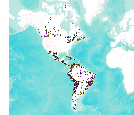Filters: Tags: Kaolin (X)
10 results (41ms)|
Filters
Date Range
Types Contacts
Categories Tag Types Tag Schemes |
Fine-grained sediments, or “fines,” are nearly ubiquitous in natural sediments, even in the predominantly coarse-grained sediments that host gas hydrates. Fines within these sandy sediments can be mobilized and subsequently clog flow pathways while methane is being extracted from gas hydrate as an energy resource. Using two-dimensional (2D) micromodels to test the conditions in which clogging occurs provides insights for choosing production operation parameters that optimize methane recovery in the field. During methane extraction, several processes can alter the mobility and clogging potential of fines: (1) fluid flow as the formation is depressurized to release methane from gas hydrate, (2) shifting pore-fluid...
Categories: Data;
Tags: 2D micromodel,
Bay of Bengal,
Department of Civil and Environmental Engineering,
Geophysics,
Indian Ocean,
This data release contains the U.S. salient statistics and world production data extracted from the CLAYS data sheet of the USGS Mineral Commodity Summaries 2024.
This data release contains the U.S. salient statistics and world production data extracted from the CLAYS data sheet of the USGS Mineral Commodity Summaries 2022.
The safety, effectiveness and longevity of many construction and geotechnical engineering projects rely on correctly accounting for the evolution of soil properties over time. Critical sediment properties, such as compressibility, can change in response to pore-fluid chemistry changes, particularly if the sediment contains appreciable concentrations of fine-grained materials. Pore-fluid changes act at the micro scale, altering interactions between sediment particles, or between sediment particles and the pore fluid. These micro-scale alterations change how sediment fabrics and void ratios develop, which directly impacts macro-scale properties such as sediment compressibility. The goal of this study is to correlate...
Categories: Data;
Tags: CMGP,
Coastal and Marine Geology Program,
Laboratory,
U.S. Geological Survey,
U.S. Geological Survey,

This data set includes mineral and metal operations in the United States. The data represent commodities monitored by the National Minerals Information Center of the USGS, and the operations included are those considered active in 2003 and surveyed by the MIT. Additional mineral and metal operations information can be obtained from the U.S. Geological Survey National Minerals Information Center web page at: <http://minerals.usgs.gov/minerals/>
This data release contains the U.S. salient statistics and world production data extracted from the CLAYS data sheet of the USGS Mineral Commodity Summaries 2023.

This data set consists of records for over 900 mineral facilities in Latin America and Canada. The mineral facilities include mines, plants, smelters, or refineries of aluminum, cement, coal, copper, diamond, gold, iron and steel, nickel, platinum-group metals, salt, and silver, among others. Records include attributes such as commodity, country, location, company name, facility type and capacity if applicable, and generalized coordinates. The data were compiled from multiple sources, including the 2003 and 2004 USGS Minerals Yearbooks (Latin America and Candada volume), data to be published in the 2005 Minerals Yearbook Latin America and Canada Volume, minerals statistics and information from the USGS minerals...
Types: Map Service,
OGC WFS Layer,
OGC WMS Layer,
OGC WMS Service;
Tags: Kaolin,
Macon County, Georgia
The safety, effectiveness and longevity of many construction and geotechnical engineering projects rely on correctly accounting for the evolution of soil properties over time. Critical sediment properties, such as compressibility, can change in response to pore-fluid chemistry changes, particularly if the sediment contains appreciable concentrations of fine-grained materials. Pore-fluid changes act at the micro scale, altering interactions between sediment particles, or between sediment particles and the pore fluid. These micro-scale alterations change how sediment fabrics and void ratios develop, which directly impacts macro-scale properties such as sediment compressibility. The goal of this study is to correlate...
Categories: Data;
Tags: CMGP,
Coastal and Marine Geology Program,
Laboratory,
U.S. Geological Survey,
U.S. Geological Survey,

This dataset consists of records for over 1,500 mineral facilities in Africa and the Middle East. The mineral facilities include mines, plants, mills , or refineries of aluminum, cement, coal, copper, diamond, gold, iron and steel, nickel, platinum-group metals, salt, and silver, among others. Records include attributes such as commodity, country, site, company name, plant capacity if applicable, and generalized coordinates. The data were compiled from multiple sources, including the 2004 USGS Minerals Yearbook (Africa and Middle East volume), minerals statistics and information from the USGS minerals information Web site (http://minerals.usgs.gov/minerals/), and data collected by USGS minerals information country...
|

|